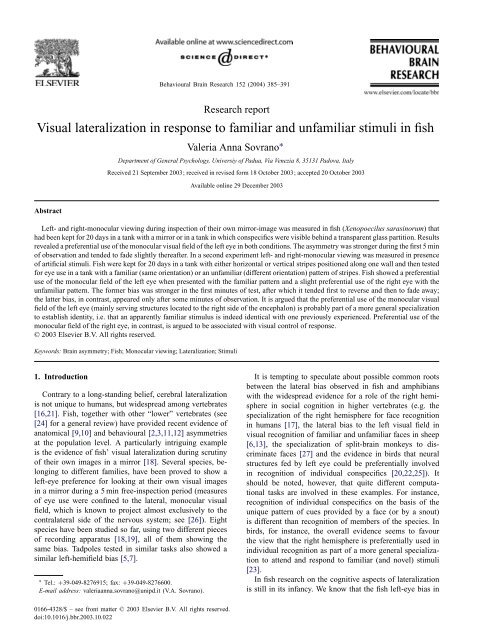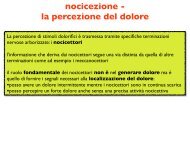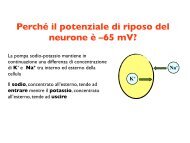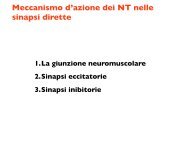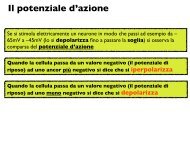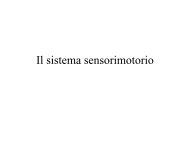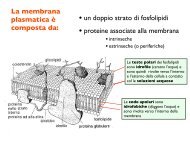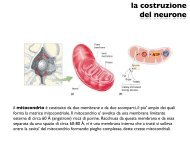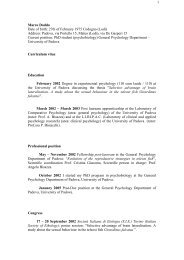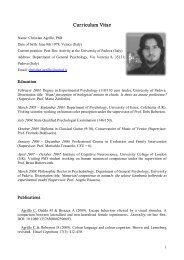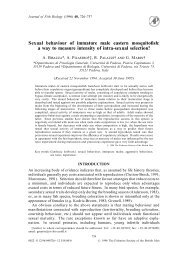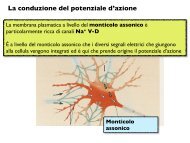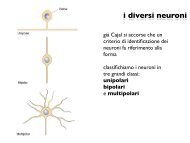Visual lateralization in response to familiar and unfamiliar ... - CPRG
Visual lateralization in response to familiar and unfamiliar ... - CPRG
Visual lateralization in response to familiar and unfamiliar ... - CPRG
You also want an ePaper? Increase the reach of your titles
YUMPU automatically turns print PDFs into web optimized ePapers that Google loves.
Behavioural Bra<strong>in</strong> Research 152 (2004) 385–391<br />
Research report<br />
<strong>Visual</strong> <strong>lateralization</strong> <strong>in</strong> <strong>response</strong> <strong>to</strong> <strong>familiar</strong> <strong>and</strong> un<strong>familiar</strong> stimuli <strong>in</strong> fish<br />
Abstract<br />
Valeria Anna Sovrano ∗<br />
Department of General Psychology, Universiy of Padua, Via Venezia 8, 35131 Padova, Italy<br />
Received 21 September 2003; received <strong>in</strong> revised form 18 Oc<strong>to</strong>ber 2003; accepted 20 Oc<strong>to</strong>ber 2003<br />
Available onl<strong>in</strong>e 29 December 2003<br />
Left- <strong>and</strong> right-monocular view<strong>in</strong>g dur<strong>in</strong>g <strong>in</strong>spection of their own mirror-image was measured <strong>in</strong> fish (Xenopoecilus saras<strong>in</strong>orum) that<br />
had been kept for 20 days <strong>in</strong> a tank with a mirror or <strong>in</strong> a tank <strong>in</strong> which conspecifics were visible beh<strong>in</strong>d a transparent glass partition. Results<br />
revealed a preferential use of the monocular visual field of the left eye <strong>in</strong> both conditions. The asymmetry was stronger dur<strong>in</strong>g the first 5 m<strong>in</strong><br />
of observation <strong>and</strong> tended <strong>to</strong> fade slightly thereafter. In a second experiment left- <strong>and</strong> right-monocular view<strong>in</strong>g was measured <strong>in</strong> presence<br />
of artificial stimuli. Fish were kept for 20 days <strong>in</strong> a tank with either horizontal or vertical stripes positioned along one wall <strong>and</strong> then tested<br />
for eye use <strong>in</strong> a tank with a <strong>familiar</strong> (same orientation) or an un<strong>familiar</strong> (different orientation) pattern of stripes. Fish showed a preferential<br />
use of the monocular field of the left eye when presented with the <strong>familiar</strong> pattern <strong>and</strong> a slight preferential use of the right eye with the<br />
un<strong>familiar</strong> pattern. The former bias was stronger <strong>in</strong> the first m<strong>in</strong>utes of test, after which it tended first <strong>to</strong> reverse <strong>and</strong> then <strong>to</strong> fade away;<br />
the latter bias, <strong>in</strong> contrast, appeared only after some m<strong>in</strong>utes of observation. It is argued that the preferential use of the monocular visual<br />
field of the left eye (ma<strong>in</strong>ly serv<strong>in</strong>g structures located <strong>to</strong> the right side of the encephalon) is probably part of a more general specialization<br />
<strong>to</strong> establish identity, i.e. that an apparently <strong>familiar</strong> stimulus is <strong>in</strong>deed identical with one previously experienced. Preferential use of the<br />
monocular field of the right eye, <strong>in</strong> contrast, is argued <strong>to</strong> be associated with visual control of <strong>response</strong>.<br />
© 2003 Elsevier B.V. All rights reserved.<br />
Keywords: Bra<strong>in</strong> asymmetry; Fish; Monocular view<strong>in</strong>g; Lateralization; Stimuli<br />
1. Introduction<br />
Contrary <strong>to</strong> a long-st<strong>and</strong><strong>in</strong>g belief, cerebral <strong>lateralization</strong><br />
is not unique <strong>to</strong> humans, but widespread among vertebrates<br />
[16,21]. Fish, <strong>to</strong>gether with other “lower” vertebrates (see<br />
[24] for a general review) have provided recent evidence of<br />
ana<strong>to</strong>mical [9,10] <strong>and</strong> behavioural [2,3,11,12] asymmetries<br />
at the population level. A particularly <strong>in</strong>trigu<strong>in</strong>g example<br />
is the evidence of fish’ visual <strong>lateralization</strong> dur<strong>in</strong>g scrut<strong>in</strong>y<br />
of their own images <strong>in</strong> a mirror [18]. Several species, belong<strong>in</strong>g<br />
<strong>to</strong> different families, have been proved <strong>to</strong> show a<br />
left-eye preference for look<strong>in</strong>g at their own visual images<br />
<strong>in</strong> a mirror dur<strong>in</strong>g a 5 m<strong>in</strong> free-<strong>in</strong>spection period (measures<br />
of eye use were conf<strong>in</strong>ed <strong>to</strong> the lateral, monocular visual<br />
field, which is known <strong>to</strong> project almost exclusively <strong>to</strong> the<br />
contralateral side of the nervous system; see [26]). Eight<br />
species have been studied so far, us<strong>in</strong>g two different pieces<br />
of record<strong>in</strong>g apparatus [18,19], all of them show<strong>in</strong>g the<br />
same bias. Tadpoles tested <strong>in</strong> similar tasks also showed a<br />
similar left-hemifield bias [5,7].<br />
∗ Tel.: +39-049-8276915; fax: +39-049-8276600.<br />
E-mail address: valeriaanna.sovrano@unipd.it (V.A. Sovrano).<br />
0166-4328/$ – see front matter © 2003 Elsevier B.V. All rights reserved.<br />
doi:10.1016/j.bbr.2003.10.022<br />
It is tempt<strong>in</strong>g <strong>to</strong> speculate about possible common roots<br />
between the lateral bias observed <strong>in</strong> fish <strong>and</strong> amphibians<br />
with the widespread evidence for a role of the right hemisphere<br />
<strong>in</strong> social cognition <strong>in</strong> higher vertebrates (e.g. the<br />
specialization of the right hemisphere for face recognition<br />
<strong>in</strong> humans [17], the lateral bias <strong>to</strong> the left visual field <strong>in</strong><br />
visual recognition of <strong>familiar</strong> <strong>and</strong> un<strong>familiar</strong> faces <strong>in</strong> sheep<br />
[6,13], the specialization of split-bra<strong>in</strong> monkeys <strong>to</strong> discrim<strong>in</strong>ate<br />
faces [27] <strong>and</strong> the evidence <strong>in</strong> birds that neural<br />
structures fed by left eye could be preferentially <strong>in</strong>volved<br />
<strong>in</strong> recognition of <strong>in</strong>dividual conspecifics [20,22,25]). It<br />
should be noted, however, that quite different computational<br />
tasks are <strong>in</strong>volved <strong>in</strong> these examples. For <strong>in</strong>stance,<br />
recognition of <strong>in</strong>dividual conspecifics on the basis of the<br />
unique pattern of cues provided by a face (or by a snout)<br />
is different than recognition of members of the species. In<br />
birds, for <strong>in</strong>stance, the overall evidence seems <strong>to</strong> favour<br />
the view that the right hemisphere is preferentially used <strong>in</strong><br />
<strong>in</strong>dividual recognition as part of a more general specialization<br />
<strong>to</strong> attend <strong>and</strong> respond <strong>to</strong> <strong>familiar</strong> (<strong>and</strong> novel) stimuli<br />
[23].<br />
In fish research on the cognitive aspects of <strong>lateralization</strong><br />
is still <strong>in</strong> its <strong>in</strong>fancy. We know that the fish left-eye bias <strong>in</strong>
386 V.A. Sovrano / Behavioural Bra<strong>in</strong> Research 152 (2004) 385–391<br />
look<strong>in</strong>g at their own image <strong>in</strong> a mirror is not a manifestation<br />
of a generic preference <strong>to</strong> use this eye <strong>to</strong> look at all visual<br />
stimuli because the right eye is used <strong>in</strong> preference <strong>in</strong> other<br />
tasks, for <strong>in</strong>stance <strong>to</strong> <strong>in</strong>spect a preda<strong>to</strong>r or other potentially<br />
dangerous stimuli [8] or when decid<strong>in</strong>g <strong>to</strong> perform a certa<strong>in</strong><br />
course of action on a stimulus, such as <strong>to</strong> bite it [11]. However,<br />
it is unclear what specific aspects of the mirror-image<br />
would attract the attention of the left eye <strong>and</strong> the associated<br />
neural structures. Here we have started an <strong>in</strong>vestigation<br />
of this issue. In the first experiment we tried <strong>to</strong> check<br />
whether the degree of <strong>familiar</strong>ity with the images provided<br />
by a mirror would affect the lateral bias. For a naïve fish,<br />
its mirror-image is the image of a stranger conspecific. Do<br />
fish accus<strong>to</strong>med <strong>to</strong> a mirror would still manifest a left lateral<br />
bias <strong>in</strong> the use of the eyes?<br />
2. Experiment 1<br />
All evidence collected so far concerned fish that were<br />
presented for the first time with a mirror. In the present<br />
experiment fish were tested after a long exposure <strong>to</strong> a mirror.<br />
As a control, we also devised an experimental condition <strong>in</strong><br />
which fish were exposed, for the same amount of time, <strong>to</strong> the<br />
same number of conspecifics see<strong>in</strong>g as real animals beh<strong>in</strong>d<br />
a glass rather than as images <strong>in</strong> a mirror.<br />
2.1. Materials <strong>and</strong> methods<br />
2.1.1. Subjects<br />
Females of Xenopoecilus saras<strong>in</strong>orum (N = 24) were<br />
used. Fish were kept <strong>in</strong><strong>to</strong> vegetation rich (Cera<strong>to</strong>phyllum<br />
sp.) 120–150 l glass tanks (99 cm × 45 cm × 52.5 cm), illum<strong>in</strong>ated<br />
from above by fluorescent lamps (30 W) under a<br />
14:00-h light:10:00-h dark period. Water temperature was<br />
ma<strong>in</strong>ta<strong>in</strong>ed between 22 <strong>and</strong> 25 ◦ C <strong>and</strong> fish were fed dry food<br />
twice a day.<br />
2.1.2. Apparatus <strong>and</strong> procedure<br />
Twenty-one days before the start of the test fish were removed<br />
from the communal tank <strong>and</strong> r<strong>and</strong>omly subdivided<br />
<strong>in</strong> two different rear<strong>in</strong>g conditions (see Fig. 1). In one condition<br />
(N = 12) fish were placed <strong>in</strong> groups of three animals<br />
<strong>in</strong> smaller rectangular glass tanks (48 cm × 19 cm × 32 cm),<br />
covered with opaque plastic material, with one of the longer<br />
wall entirely occupied by a mirror (48 cm × 27 cm). In the<br />
other condition (N = 12) fish were placed <strong>in</strong> groups of three<br />
animals <strong>in</strong> tanks identical <strong>to</strong> those used <strong>in</strong> the other condition.<br />
However, this time there was no mirror along the longer<br />
wall, which was <strong>in</strong>stead occupied by a transparent glass wall<br />
of an adjacent tank (see Fig. 1), so that the fish could be exposed<br />
<strong>to</strong> an environment similar <strong>to</strong> that of the fish exposed<br />
<strong>to</strong> the mirror (i.e. they could see three conspecifics on the<br />
other side <strong>and</strong> the mirror-image of the tank).<br />
The apparatus has been described <strong>in</strong> details elsewhere<br />
[18]. Test<strong>in</strong>g was performed with<strong>in</strong> a tank (44 cm ×22 cm ×<br />
30 cm), <strong>in</strong>serted <strong>in</strong><strong>to</strong> a larger tank (60 cm × 36 cm × 35 cm),<br />
with mirrors as the two longer walls <strong>and</strong> opaque screens as<br />
the shorter walls (see Fig. 2). The tank was lit from above<br />
by a neon lamp (18 W); water was 25 cm <strong>in</strong> height. Above<br />
the test<strong>in</strong>g apparatus a videocamera was mounted <strong>in</strong> order<br />
<strong>to</strong> videotape the fish behaviour. Fish exposed <strong>to</strong> the mirror<br />
<strong>and</strong> fish exposed <strong>to</strong> conspecifics were tested <strong>in</strong> the same<br />
way. Each fish was tested s<strong>in</strong>gly, by plac<strong>in</strong>g it <strong>in</strong><strong>to</strong> the test<br />
apparatus <strong>and</strong> videorecord<strong>in</strong>g its behaviour for 15 m<strong>in</strong> (for<br />
subsequent analysis, this period was split <strong>in</strong><strong>to</strong> three blocks<br />
of 5 m<strong>in</strong> <strong>in</strong> order <strong>to</strong> check for variation <strong>in</strong> <strong>lateralization</strong> as<br />
a function of time). Fish positions were then scored every<br />
2 s, <strong>and</strong> the frequency of use of the left- or right-monocular<br />
visual field was estimated on the basis of the fish angle with<br />
respect <strong>to</strong> the closest mirror (see Fig. 2 <strong>and</strong> [18] for details].<br />
An <strong>in</strong>dex of eye use was calculated as: [(frequency<br />
of right-eye use)/(frequency of right-eye use + frequency<br />
of left-eye use)] × 100. Significant departures from chance<br />
level (50%) were estimated by one- or two-tailed one sam-<br />
Fig. 1. Schematic representation of the rear<strong>in</strong>g conditions used <strong>in</strong> Experiment 1.
V.A. Sovrano / Behavioural Bra<strong>in</strong> Research 152 (2004) 385–391 387<br />
Fig. 2. Schematic representation of the mirror-test apparatus, show<strong>in</strong>g the position of the mirrors <strong>and</strong> the angles of view<strong>in</strong>g that def<strong>in</strong>ed monocular vision<br />
with the right or left eye. Data were discarded when the fish was perpendicular <strong>to</strong> the mirror (b<strong>in</strong>ocular stimulation, dotted fish) or when it formed an<br />
angle larger than 90 ◦ with respect <strong>to</strong> the closest mirror.<br />
ple t-tests. Differences between rear<strong>in</strong>g conditions (below)<br />
<strong>and</strong> time (first, second <strong>and</strong> third 5 m<strong>in</strong> of test) were estimated<br />
by analysis of variance (Anova). (Normality of distribution<br />
<strong>and</strong> any need for data transformation <strong>to</strong> account for<br />
heterogeneity of variances were checked for before apply<strong>in</strong>g<br />
Anovas.)<br />
2.1.3. Results <strong>and</strong> discussion<br />
The results are shown <strong>in</strong> Fig. 3. The Anova revealed<br />
that the ma<strong>in</strong> effect of time (first, second <strong>and</strong> third 5 m<strong>in</strong>)<br />
was statistically significant (F(2, 44) = 3.307, P = 0.046),<br />
whereas the ma<strong>in</strong> effect of <strong>familiar</strong>ity (mirror vs. conspecifics)<br />
<strong>and</strong> the <strong>familiar</strong>ity × time <strong>in</strong>teraction were not<br />
significant (F(1, 22) = 1.102, n.s.; F(2, 44) = 0.077,<br />
n.s., respectively). One-sample t-tests revealed that <strong>in</strong> both<br />
groups of fish there was a significant preference for us<strong>in</strong>g<br />
the left eye throughout the entire test<strong>in</strong>g period (first 5 m<strong>in</strong>:<br />
t(23) = 4.546, P = 0.0001; second 5 m<strong>in</strong>: t(23) = 2.053,<br />
P = 0.052; third 5 m<strong>in</strong>: t(23) = 2.295, P = 0.031), with<br />
only a m<strong>in</strong>or reduction of the bias as a function of the<br />
test<strong>in</strong>g time (see Fig. 3).<br />
The results showed that the degree of <strong>familiar</strong>ization<br />
with the stimuli provided by a mirror is not a crucial<br />
variable for the left-eye bias <strong>to</strong> occur. The strength of <strong>lateralization</strong><br />
determ<strong>in</strong>ed <strong>in</strong> these experiments was basically<br />
the same as <strong>in</strong> previous experiments <strong>in</strong> which the fish had<br />
Fig. 3. Laterality <strong>in</strong>dex <strong>in</strong>dicat<strong>in</strong>g preferences for left <strong>and</strong> right eye use (mean ± S.E.M. are shown) dur<strong>in</strong>g the first, second <strong>and</strong> third 5 m<strong>in</strong> of observation<br />
<strong>in</strong> fish reared with a mirror or with conspecifics.
388 V.A. Sovrano / Behavioural Bra<strong>in</strong> Research 152 (2004) 385–391<br />
received no prior <strong>familiar</strong>ization with their mirror-images<br />
[18]. Moreover, it is also clear from the experiment that<br />
the lateral bias is not associated with some special feature<br />
perceived as a result of the mirror stimulation, such as an<br />
unsual behaviour of the fish companions when see<strong>in</strong>g as<br />
mirror-images, because it occurred identically <strong>in</strong> fish accus<strong>to</strong>med<br />
<strong>to</strong> a mirror <strong>and</strong> <strong>in</strong> fish accus<strong>to</strong>med <strong>to</strong> “real” images of<br />
conspecifics.<br />
3. Experiment 2<br />
The results of the Experiment 1, <strong>to</strong>gether with previous<br />
evidence (see Section 1), clearly showed that fish tend <strong>to</strong><br />
use their left monocular visual field <strong>to</strong> scrut<strong>in</strong>ise the image<br />
of a conspecific, whether <strong>familiar</strong> or not. It could be that<br />
there is someth<strong>in</strong>g special <strong>in</strong> conspecifics as visual stimuli;<br />
alternatively, it could be that the <strong>lateralization</strong> is associated<br />
with the fact that these stimuli are highly <strong>familiar</strong>. (Note that<br />
even fish not accus<strong>to</strong>med <strong>to</strong> a mirror used <strong>in</strong> previous studies<br />
were nonetheless reared socially <strong>and</strong> thus <strong>familiar</strong> with the<br />
visual aspect of their conspecifics; see [18].) To check for<br />
this <strong>in</strong> the follow<strong>in</strong>g experiment we used artificial stimuli<br />
(square-wave grat<strong>in</strong>gs), with which fish were <strong>familiar</strong>ized<br />
<strong>to</strong> the same amount of time used <strong>in</strong> Experiment 1 us<strong>in</strong>g<br />
natural (or mirror-images of) conspecifics. Then fish were<br />
tested with the <strong>familiar</strong>, unchanged, version of the stimuli<br />
(a square-wave grat<strong>in</strong>g of the same orientation) or with a<br />
novel version of it (a square-wave grat<strong>in</strong>g of a different<br />
orientation).<br />
3.1. Materials <strong>and</strong> methods<br />
3.1.1. Subjects<br />
Females of X. saras<strong>in</strong>orum (N = 24) were used as subjects.<br />
Fish were entirely naive (never used before). Rear<strong>in</strong>g<br />
conditions were the same as <strong>in</strong> Experiment 1.<br />
3.1.2. Apparatus <strong>and</strong> procedure<br />
Twenty-one days before the start of the test fish were<br />
removed from the communal tank <strong>and</strong> r<strong>and</strong>omly subdivided<br />
<strong>in</strong> two different rear<strong>in</strong>g conditions (Fig. 4). In one condition<br />
(N = 12) fish were placed <strong>in</strong> groups of three animals <strong>in</strong><br />
smaller rectangular glass tanks identical <strong>to</strong> those used <strong>in</strong><br />
Experiment 1, covered with opaque plastic material, with<br />
one of the longer wall (48 cm×27 cm) entirely occupied by a<br />
square-wave grat<strong>in</strong>g made of a periodic pattern of horizontal<br />
black <strong>and</strong> green stripes (48 cm×3 cm). In the other condition<br />
(N = 12) fish were placed <strong>in</strong> groups of three animals <strong>in</strong><br />
tanks identical <strong>to</strong> those used <strong>in</strong> the former condition except<br />
that the stripes were vertical (3 cm × 27 cm).<br />
At test fish were placed <strong>in</strong> an apparatus identical <strong>to</strong><br />
that described <strong>in</strong> Experiment 1, except that this time there<br />
were no mirrors at the longer walls but a vertical- or a<br />
horizontal-stripes pattern that occupied the same size occupied<br />
by the mirror <strong>in</strong> Experiment 1. One-half of the fish<br />
reared with the vertical stripes was tested with the vertical<br />
stripes (<strong>familiar</strong>) <strong>and</strong> one-half with the horizontal stripes<br />
(un<strong>familiar</strong>); one-half of the fish reared with the horizontal<br />
stripes was tested with the horizontal stripes (<strong>familiar</strong>) <strong>and</strong><br />
one-half with the vertical stripes (un<strong>familiar</strong>). All other<br />
test<strong>in</strong>g <strong>and</strong> record<strong>in</strong>g conditions were the same as <strong>in</strong> Experiment<br />
1.<br />
Data have been analysed by Anova with two betweensubject<br />
fac<strong>to</strong>rs, test<strong>in</strong>g conditions (<strong>familiar</strong> vs. un<strong>familiar</strong>)<br />
<strong>and</strong> orientation (vertical vs. horizontal), <strong>and</strong> one with<strong>in</strong>subjects<br />
fac<strong>to</strong>r, time (first, second, <strong>and</strong> third 5 m<strong>in</strong> of test).<br />
3.1.3. Results <strong>and</strong> discussion<br />
Results are shown <strong>in</strong> Fig. 5. The Anova showed that the<br />
ma<strong>in</strong> effects of test<strong>in</strong>g conditions <strong>and</strong> orientation <strong>and</strong> the<br />
test<strong>in</strong>g conditions × orientation <strong>in</strong>teraction were not significant<br />
(F(1, 20) = 3.027, P = 0.097; F(1, 20) = 0.136,<br />
n.s; F(1, 20) = 0.228, n.s., respectively). The ma<strong>in</strong> effect<br />
of time was significant (F(2, 40) = 5.324, P = 0.009) as<br />
Fig. 4. Schematic representation of the rear<strong>in</strong>g conditions used <strong>in</strong> Experiment 2.
V.A. Sovrano / Behavioural Bra<strong>in</strong> Research 152 (2004) 385–391 389<br />
Fig. 5. Laterality <strong>in</strong>dex <strong>in</strong>dicat<strong>in</strong>g preferences for left <strong>and</strong> right eye use (mean ± S.E.M. are shown) dur<strong>in</strong>g the first, second <strong>and</strong> third 5 m<strong>in</strong> of observation<br />
<strong>in</strong> fish tested with <strong>familiar</strong> or un<strong>familiar</strong> stripes orientation.<br />
well as the time × test<strong>in</strong>g conditions <strong>in</strong>teraction (F(2, 40) =<br />
3.163, P = 0.05). There were no other statistically significant<br />
effects (time × orientation F(2, 40) = 0.930; time ×<br />
orientation × test<strong>in</strong>g conditions F(2, 40) = 1.709).<br />
Separate analyses for the first, second <strong>and</strong> third 5 m<strong>in</strong> were<br />
then carried out. The analyses revealed a significant ma<strong>in</strong><br />
effect of test<strong>in</strong>g conditions dur<strong>in</strong>g the first 5 m<strong>in</strong> (F(1, 20) =<br />
5.819, P = 0.026), but not <strong>in</strong> the second 5 m<strong>in</strong> (F(1, 20) =<br />
0.183, n.s.). In the third 5 m<strong>in</strong> there was only a trend for a<br />
significant difference (F(1, 20) = 3.037, P = 0.097).<br />
In the first 5 m<strong>in</strong>, fish tested with the <strong>familiar</strong> stripes<br />
showed a significant preference for us<strong>in</strong>g their left eye<br />
(t(11) = 2.38, P < 0.05), whereas fish tested with the<br />
un<strong>familiar</strong> stripes showed no bias (t(11) = 0.78, n.s.).<br />
In the second 5 m<strong>in</strong> there was no evidence for any effect<br />
of the test<strong>in</strong>g conditions (above) <strong>and</strong> thus data were<br />
lumped <strong>to</strong>gether reveal<strong>in</strong>g an overall significant bias for<br />
us<strong>in</strong>g the right eye (t(23) = 2.00, P = 0.05). F<strong>in</strong>ally, <strong>in</strong><br />
the last 5 m<strong>in</strong> there was a trend for a difference between<br />
the two test<strong>in</strong>g conditions (above), but not clear bias appeared<br />
(<strong>familiar</strong>: t(11) = 0.79, n.s.; un<strong>familiar</strong>: t(11) =<br />
1.403, n.s.).<br />
The results showed that the left eye bias can be observed,<br />
dur<strong>in</strong>g <strong>in</strong>itial <strong>in</strong>spection of visual stimuli, even for <strong>familiar</strong><br />
artificial stimuli, <strong>and</strong> therefore it is not conf<strong>in</strong>ed <strong>to</strong> natural<br />
conspecifics. Interest<strong>in</strong>gly, however, whereas the left-eye<br />
bias observed with the mirror tended <strong>to</strong> be ma<strong>in</strong>ta<strong>in</strong>ed over<br />
extended observation periods, show<strong>in</strong>g only weak fad<strong>in</strong>g<br />
with time, the time course observed with artificial stimuli<br />
is much more complex. There is <strong>in</strong> fact a shift from left <strong>to</strong><br />
right-eye use for <strong>familiar</strong> stimuli with time, <strong>and</strong> then a fad<strong>in</strong>g<br />
of the bias; whereas for un<strong>familiar</strong> stimuli a slight ten-<br />
dency <strong>to</strong>wards a right-eye bias is apparent only <strong>in</strong> the last<br />
10 m<strong>in</strong> of test.<br />
4. General discussion<br />
Previous work with several species of fish [18,19] <strong>and</strong><br />
amphibians [5,7] has revealed a clear bias <strong>to</strong> use preferentially<br />
the left monocular visual field dur<strong>in</strong>g <strong>in</strong>spection of<br />
their own mirror-images <strong>in</strong> these animals. Results from the<br />
first experiment reported here suggest that the left-hemifield<br />
bias is not due <strong>to</strong> the fact that mirrors convey the image of an<br />
un<strong>familiar</strong> conspecific. Even after 20 days of liv<strong>in</strong>g <strong>to</strong>gether<br />
with mirrors, fish of the species X. saras<strong>in</strong>orum manifest<br />
the same left bias. Quite <strong>in</strong> contrast, when accus<strong>to</strong>med <strong>to</strong><br />
the presence of artificial stimuli, fish showed a left bias only<br />
when presented with a <strong>familiar</strong> version of these stimuli, but<br />
not when presented with an un<strong>familiar</strong> version. Consider<strong>in</strong>g<br />
that even fish tested with mirrors without any habituation <strong>in</strong><br />
previous work [18,19] were nonetheless <strong>familiar</strong> with members<br />
of their own species (i.e. they had been reared socially),<br />
it is clear from these results that stimulus <strong>familiar</strong>ity (rather<br />
than stimulus specificity, i.e. be<strong>in</strong>g a social partner) is crucial<br />
<strong>in</strong> elicit<strong>in</strong>g the left-eye bias.<br />
Of course, it could be that social stimuli are special <strong>in</strong> their<br />
own. But no evidence that uniquely associate social stimuli<br />
with <strong>lateralization</strong> can be deduced from these data. It is true,<br />
for <strong>in</strong>stance, that the left-eye bias observed <strong>in</strong> the first experiment<br />
(with social stimuli) is more time-resistant than that<br />
observed <strong>in</strong> the second experiment (with artificial stimuli).<br />
However, this is probably due <strong>to</strong> the fact that mirror-images<br />
provided a cont<strong>in</strong>uous motion stimulation, whereas this is
390 V.A. Sovrano / Behavioural Bra<strong>in</strong> Research 152 (2004) 385–391<br />
not true for artificial stimuli. The only way <strong>to</strong> check for any<br />
special status of social stimuli would be hatch<strong>in</strong>g <strong>and</strong> rear<strong>in</strong>g<br />
fish deprived of any experience with members of their<br />
own species. However, consider<strong>in</strong>g that accord<strong>in</strong>g <strong>to</strong> some<br />
hypotheses [4,14,15,21] there would be a strict l<strong>in</strong>k between<br />
the development of directional <strong>lateralization</strong> <strong>and</strong> sociality,<br />
these sort of experiments may present serious difficulties of<br />
<strong>in</strong>terpretation because such animals would be socially abnormal<br />
<strong>in</strong> several respects.<br />
A possible <strong>in</strong>terpretation of the behaviour exhibited by<br />
fish <strong>in</strong> these tasks is that, once the animals are placed <strong>in</strong> the<br />
novel environment, the test-tank, they tend <strong>to</strong> orient <strong>in</strong> such<br />
a way that the left eye is used <strong>to</strong> moni<strong>to</strong>r the <strong>familiar</strong> part of<br />
the environment, possibly leav<strong>in</strong>g the right eye <strong>to</strong> scrut<strong>in</strong>ise<br />
for potentially dangerous stimuli. This would be consistent<br />
with the fact that only a slight right-eye bias was observed,<br />
after the first 5 m<strong>in</strong>, <strong>in</strong> Experiment 2 us<strong>in</strong>g un<strong>familiar</strong> stimuli.<br />
This outcome is consistent with evidence that the right eye<br />
is preferentially used <strong>to</strong> scrut<strong>in</strong>y potentially noxious stimuli,<br />
such as a preda<strong>to</strong>r [8]. When located <strong>in</strong> the test-tank with the<br />
un<strong>familiar</strong> stripes orientation, at the start fish probably do<br />
not have any clear reason <strong>to</strong> orient their right eye <strong>to</strong>wards the<br />
stripes, because these are novel but so also is the rest of the<br />
environment; only after some m<strong>in</strong>utes they turn <strong>to</strong> use their<br />
right eye <strong>to</strong>wards the stripes, but the bias rema<strong>in</strong>ed slight,<br />
probably because this stimulus is <strong>in</strong> any case a simple variation<br />
of a <strong>familiar</strong> stimulus, not a really fear-<strong>in</strong>duc<strong>in</strong>g one.<br />
Interest<strong>in</strong>gly, these data bear some resemblance with the<br />
<strong>lateralization</strong> pattern that has been observed <strong>in</strong> young domestic<br />
chicks, the only other species <strong>in</strong> which <strong>response</strong> <strong>to</strong><br />
<strong>familiar</strong> <strong>and</strong> un<strong>familiar</strong> stimuli has been tested with both<br />
natural <strong>and</strong> artificial stimuli [1,20,22]. Basically, chicks<br />
use their left eye preferentially when look<strong>in</strong>g at <strong>familiar</strong> or<br />
slightly novel highly <strong>familiar</strong> stimuli (e.g. impr<strong>in</strong>t<strong>in</strong>g objects),<br />
but turn <strong>to</strong> right eye use when view<strong>in</strong>g large novelty.<br />
Data from chicks <strong>and</strong> other species of fish may thus suggest<br />
even another, more analytical account of our f<strong>in</strong>d<strong>in</strong>gs.<br />
On Experiment 2 the <strong>in</strong>teraction time by test conditions appears<br />
<strong>to</strong> be generated by change <strong>in</strong> the group view<strong>in</strong>g a<br />
<strong>familiar</strong> pattern from left- <strong>to</strong> right-eye bias <strong>and</strong> then <strong>to</strong> no<br />
bias, whilst the group see<strong>in</strong>g the un<strong>familiar</strong> pattern does not<br />
change from slight right-eye bias. The first pattern is particularly<br />
important, s<strong>in</strong>ce it has not previously been found,<br />
probably because <strong>in</strong>sufficiently long exposures have been<br />
studied. It suggests an <strong>in</strong>itial left-eye <strong>in</strong>volvement <strong>in</strong> establishment<br />
of identity, followed by a brief period when<br />
right-eye use is called for. Why might this be? A possible<br />
clue arises from work on another fish species, the zebrafish.<br />
Miklosi <strong>and</strong> Andrew [11] found that <strong>in</strong> zebrafish right-eye<br />
use went with visual control of <strong>response</strong> (e.g. when zebrafish<br />
were about <strong>to</strong> approach <strong>and</strong> bite a target). Right-eye<br />
use when view<strong>in</strong>g a preda<strong>to</strong>r [8] can be similarly expla<strong>in</strong>ed:<br />
aga<strong>in</strong> the fish is ready <strong>to</strong> perform a <strong>response</strong> (escape) whilst<br />
view<strong>in</strong>g the object that may evoke the <strong>response</strong>. The use of<br />
the left eye with small transformations of a <strong>familiar</strong> object<br />
[22] agrees with the data for fish (here <strong>and</strong> <strong>in</strong> references<br />
cited). The <strong>in</strong>itial use of the left eye <strong>to</strong> scrut<strong>in</strong>ise the <strong>familiar</strong><br />
stripes could be associated thus with the be establishment<br />
of identity, followed by a brief period when some sort of<br />
<strong>response</strong> is likely.<br />
As noted above we cannot discard the possibility that the<br />
stimuli provided by a natural conspecific would be somewhat<br />
special <strong>in</strong> elicit<strong>in</strong>g a stronger lateral bias; however, at<br />
present, the most parsimonious <strong>in</strong>terpretation of the data is<br />
that the preferential use of the left monocular visual field is<br />
associated with establishment of identity of <strong>familiar</strong> stimuli,<br />
either social or not social.<br />
Acknowledgements<br />
I thank Professors Angelo Bisazza <strong>and</strong> Giorgio Vallortigara<br />
<strong>and</strong> two anonymous reviewers for thoughtful comments<br />
on the manuscript, <strong>and</strong> Marco Dadda for help with care of<br />
the animals’ <strong>and</strong> preparation of the stimuli.<br />
References<br />
[1] Andrew RJ. The nature of behavioural <strong>lateralization</strong> <strong>in</strong> the chick. In:<br />
Andrew RJ, edi<strong>to</strong>r. Neural <strong>and</strong> behavioural plasticity. The use of the<br />
chick as a model. Oxford: Oxford University Press; 1991. p. 536–54.<br />
[2] Bisazza A, Pignatti R, Vallortigara G. De<strong>to</strong>ur tests reveal task<strong>and</strong><br />
stimulus-specific neural <strong>lateralization</strong> <strong>in</strong> mosqui<strong>to</strong>fish (Gambusia<br />
holbrooki). Behav Bra<strong>in</strong> Res 1997;89:237–42.<br />
[3] Bisazza A, Pignatti R, Vallortigara G. Laterality <strong>in</strong> de<strong>to</strong>ur behaviour:<br />
<strong>in</strong>terspecific variation <strong>in</strong> poeciliid fish. Anim Behav 1997;54:1273–<br />
81.<br />
[4] Bisazza A, Cantalupo C, Capocchiano M, Vallortigara G. Population<br />
<strong>lateralization</strong> <strong>and</strong> social behaviour: a study with sixteen species of<br />
fish. Laterality 2000;5:269–84.<br />
[5] Bisazza A, De Santi A, Bonso S, Sovrano VA. Frogs <strong>and</strong> <strong>to</strong>ads<br />
<strong>in</strong> front of a mirror: lateralisation of <strong>response</strong> <strong>to</strong> social stimuli <strong>in</strong><br />
tadpoles of five anuran species. Behav Bra<strong>in</strong> Res 2002;134:417–24.<br />
[6] Broad KD, Mimmack ML, Kendrick KM. Is right hemisphere specialization<br />
for face discrim<strong>in</strong>ation specific <strong>to</strong> humans? Europ J Neurosci<br />
2000;12:731–41.<br />
[7] Dadda M, Sovrano VA, Bisazza A. Temporal pattern of social aggregation<br />
<strong>and</strong> its <strong>in</strong>fluence on the measurement of lateralized <strong>response</strong><br />
<strong>to</strong> social stimuli. Physiol Behav 2003;78:337–41.<br />
[8] De Santi A, Sovrano VA, Bisazza A, Vallortigara G. Mosqui<strong>to</strong>fish display<br />
differential left- <strong>and</strong> right-eye use dur<strong>in</strong>g mirror-image scrut<strong>in</strong>y<br />
<strong>and</strong> preda<strong>to</strong>r-<strong>in</strong>spection <strong>response</strong>s. Anim Behav 2001;61:305–10.<br />
[9] Gamse JT, Thisse C, Thisse B, Halpern ME. The parap<strong>in</strong>eal mediates<br />
left-right asymmetry <strong>in</strong> the zebrafish diencephalons. Development<br />
2003;130:1059–68.<br />
[10] Heuts BA. Lateralization of trunk muscle volume, <strong>and</strong> <strong>lateralization</strong><br />
of swimm<strong>in</strong>g turns of fish respond<strong>in</strong>g <strong>to</strong> external stimuli. Behav<br />
Process 1999;47:113–24.<br />
[11] Miklosi A, Andrew RJ. Right eye use associated with decision <strong>to</strong><br />
bite <strong>in</strong> zebrafish. Behav Bra<strong>in</strong> Res 1999;105:199–205.<br />
[12] Miklosi A, Andrew RJ, Savage H. Behavioural lateralisation of the<br />
tetrapod type <strong>in</strong> the zebrafish (Brachydanio rerio). Physiol Behav<br />
1998;63:127–35.<br />
[13] Peirce JW, Leigh AE, Kendrick KM. Configurational cod<strong>in</strong>g, <strong>familiar</strong>ity<br />
<strong>and</strong> the right hemisphere advantage for face recognition <strong>in</strong><br />
sheep. Neuropsychologia 2000;38:475–83.<br />
[14] Rogers LJ. Laterality <strong>in</strong> animals. Int J Comp Psychol 1989;3:5–25.
[15] Rogers LJ. Evolution of hemispheric specialization: advantages <strong>and</strong><br />
disadvantages. Bra<strong>in</strong> Lang 2000;73:236–53.<br />
[16] Rogers LJ, Andrew RJ. Comparative vertebrate <strong>lateralization</strong>. Cambridge,<br />
U.K: Cambridge University Press; 2002.<br />
[17] Sergent J, Signoret J-L. Functional <strong>and</strong> ana<strong>to</strong>mical decomposition<br />
of face process<strong>in</strong>g: evidence from prosopagnosia <strong>and</strong> PET study of<br />
normal subjects. Phil Trans R Soc Lond B 1992;335:55–62.<br />
[18] Sovrano VA, Ra<strong>in</strong>oldi C, Bisazza A, Vallortigara G. Roots of bra<strong>in</strong><br />
specializations: preferential left-eye use dur<strong>in</strong>g mirror-image <strong>in</strong>spection<br />
<strong>in</strong> six species of teleost fish. Behav Bra<strong>in</strong> Res 1999;106:175–80.<br />
[19] Sovrano VA, Bisazza A, Vallortigara G. Lateralization of <strong>response</strong><br />
<strong>to</strong> social stimuli <strong>in</strong> fishes: a comparison between different methods<br />
<strong>and</strong> species. Physiol Behav 2001;74:237–44.<br />
[20] Vallortigara G. Right hemisphere advantage for social recognition <strong>in</strong><br />
the chick. Neuropsychologia 1992;30:761–8.<br />
[21] Vallortigara G. Comparative neuropsychology of the dual bra<strong>in</strong>: a<br />
stroll through left <strong>and</strong> right animals’ perceptual worlds. Bra<strong>in</strong> Lang<br />
2000;73:189–219.<br />
V.A. Sovrano / Behavioural Bra<strong>in</strong> Research 152 (2004) 385–391 391<br />
[22] Vallortigara G, Andrew RJ. Lateralization of <strong>response</strong> <strong>to</strong> change <strong>in</strong><br />
a model partner by chicks. Anim Behav 1991;41:187–94.<br />
[23] Vallortigara G, Andrew RJ. Differential <strong>in</strong>volvement of right <strong>and</strong> left<br />
hemisphere <strong>in</strong> <strong>in</strong>dividual recognition <strong>in</strong> the domestic chick. Behav<br />
Process 1994;33:41–58.<br />
[24] Vallortigara G, Bisazza A. How ancient is bra<strong>in</strong> <strong>lateralization</strong>?<br />
In: Andrew RJ, Rogers LJ, edi<strong>to</strong>rs. Comparative vertebrate <strong>lateralization</strong>.<br />
Cambridge: Cambridge University Press; 2002. p.<br />
9–69.<br />
[25] Vallortigara G, Cozzutti C, Tommasi L, Rogers LJ. How birds<br />
use their eyes: opposite left-right specialization for the lateral <strong>and</strong><br />
frontal visual hemifield <strong>in</strong> the domestic chick. Curr Biol 2001;11:<br />
29–33.<br />
[26] Vanegas H, I<strong>to</strong> H. Morphological aspects of the teleostean visual<br />
system: a review. Bra<strong>in</strong> Res Rev 1983;6:117–37.<br />
[27] Vermeire BA, Hamil<strong>to</strong>n CR, Erdmann AL. Right-hemispheric superiority<br />
<strong>in</strong> split-bra<strong>in</strong> monkeys for learn<strong>in</strong>g <strong>and</strong> remember<strong>in</strong>g facial<br />
discrim<strong>in</strong>ations. Behav Neurosci 1998;112:1048–61.


